Introduction to Country Chicken Farming Project Report
The following information is about Country Chicken Farming Project Report, Cost and Profit.
Introduction: Poultry has contributed to human health and rearing has been an integral component of livestock over the millennia in India. Poultry is an integral part of farming systems and household economy for many families in rural regions, while in urban regions, large and small-scale poultries are providing good quality and safe poultry products to the urban consumers. Over the last few decades, the country chicken has transformed from backyard farming to techno-commercial industry.From an entirely unorganized and unscientific farming practice; poultry industry in India has advanced in the commercial production to a great extent by adopting scientific methods, standing as the third largest egg producer and fifth in chicken meat producer in the world.
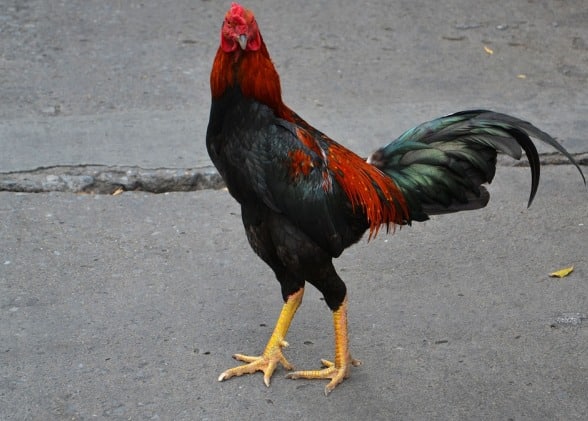
Country chicken farming is undertaken because of its nutritional meat and eggs, health benefits, economical in rearing and has social benefits. Before starting up a country chicken farming, an entrepreneur must have good knowledge on chicken housing and the different ways of how chicken can be kept, feed and its management, necessary hygienic conditions and health management practices, and finally with a proper business plan.
Country Chicken Breeds
Country Chicken Farming Project Report – Indian Pure Breeds:
There are four Indian pure breeds available.
- Asil: They are also considered as fighting cocks and used for cockfighting. These breeds have high stamina, a natural disposition to be aggressive, an impressive walking characteristic known as majestic gait and with determined fighting qualities. Few weeks old chicks exhibit fighting qualities and matured ones will fight to the death. This breed is a poor layer, laying about 40 eggs in a year but are excellent sitters. Some of the physical characteristics of the breed include, the birds have red ear lobes, over-hanging eyebrows, their shanks are featherless and with a pea comb. Peela – golden red, Nuri – white, Yakub – black and red, and Kagar – black, Chitta – black and white spotted, Java, Sabja, Teekar, and Reza are some of its popular varieties.
- Chittagong: These birds are also known as Malay. This breed is the tallest chicken breed reaching up to 90 cm tall. The birds, especially the rooster has an upright standing posture with a large skull. The birds are well muscled with a cruel facial expression. The birds are raised for its dual purpose in producing eggs and meat.
- Kadaknath: They are also called as ‘kali masi’ – birds having black flesh. This breed is in high demand as its meat contains more protein with less fat, cholesterol and believed to infuse vigor. For its good adaptability and tasty black meat, the breed is very popular. The fowls are completely black from beak to plumage and toes, even the meat with dark organs. The bird is completely black in color due to the deposition of melanin pigment.
- Busra: The breed is poor in producing eggs. The birds are medium in size and deep bodied. The birds are alert by nature and lightly feathered breed. They have a wide variation in body color.
Country Chicken Farming Project Report – CrossBreed Country Chicken:
- Chasm: This variety is developed by the AICR Project on Poultry Breeding – Bisra Agricultural University, Ranchi Centre. This variety is more adaptable to Jharkhand climatic conditions. They grow even faster under low nutrition levels, producing optimum eggs delivering dual purpose. They start laying eggs from 170 to 180 days old with a potential about 160 to 170 eggs in a year, each weighing about 50 to 55 grams. A mature bird weighs about 1.5 to 1.8 kg under backyard farming.
- Kampura: This variety is a three-way cross (Colored Broiler, Dalhem Red, and Assam local ecotype) developed by the AICR Project on Poultry Breeding – Assam Agricultural University, Guwahati. The birds have colored plumage with longer shanks. The bird lays about 115 to 130 eggs in a year with each weighing 50 grams. A 40-week old rooster can weigh between 1.8 to 2.2 kg.
- Pratapdhan: This variety is a dual purpose colored bird. This variety was developed for the Rajasthan region by the AICR Project on Poultry Breeding – MPUAT, Udaipur. This breed survives under harsh climatic conditions and has a fast growth rate even under low nutrition. A hen weighs around 1.2 to 2.7 kg, while a rooster weighs around 1.5 to 3.0 kg. The hens start laying eggs from 170 days at about 160 eggs in a year.
Breeds from Other Countries:
American Country Chicken Varieties: New Hampshire, White Plymouth Rock, Rhode Island Red and Wyandotte II.
Mediterranean Country Chicken Varieties: Leghorn, Minorca and Ancona, they are light bodied with high egg production.
English Country Chicken Varieties: Australorp, Sussex, and Orphington.
Country Chicken Farming Project Report – Country Chicken Growing Methods
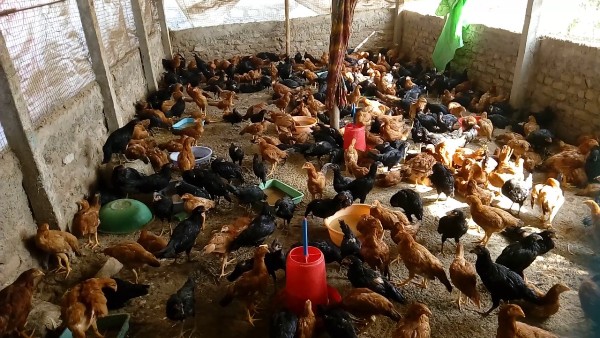
Country Chicken in Backyard: In this method, farmers rear the birds in their house by providing night shelters at the best possible location. Country chicken birds are let out to feed by scavenging the neighborhood and in the open free-range in the daytime. Cereals, kitchen waste along with fresh water is provided in the early morning before they are let out open in the daytime. Night shelters need to be well ventilated and regular proper cleaning should be done to destroy external parasites. Birds are more prone to parasitic infestation due to free-range. However, deworming every 2 to 3 months interval will keep the country chicken in good health.
Country Chicken Farming Project Report – Raising Country Chicken in Sheds: This method yields more profits compared with country chicken backyard farming. This method is also excellent for rearing country chicken commercially. Birds energy loss, gaining of body mass, and supply of quality feed on a timely basis can be provided to yield better with higher income. There are two types in shed rearing:
- Country Chicken Farming Project Report- Cage System: Country chicken up to 12 weeks old are kept in layer cage system. The biggest advantage of this system is to increase egg production to 98%, and easy handling of egg gathering along with the easy handling of chicken waste. The cage system must be designed according to the country chicken breed, for example, Asil breed requires more room space. Depending upon the availability of space and investment, cage system can accommodate 10,000+ birds. To reduce labor cost, automatic feeding and automatic egg collection equipment can be installed in large bird farms.
- Country Chicken Farming Project Report -Deep Litter System: Country chicken love growing under the deep litter system. This is more sustainable, easy to maintain, and cost-effective method. The birds are kept in the litter floor covered with litter material of about three to five-inch depth. Every fortnight, two-inch fresh litter is spread to the required drying is achieved. The open-sided shed must be provided with feed and water equipment along with nest provision. Few farmers leave the compost heap inside the chicken coop. This creates enriching of soil by dissolving of old bedding. Deep litter sheds length can be of any extent, while the width not more than 20 to 25 feet wide. The side walls have wire mesh making the poultry house look open sided. The height of the sheds in the center can be 10 to 15 feet while at the sides it can be up to six to seven feet in height. Each hen requires about two square feet and a rooster about one square foot around it for healthy living. Depending on this a farmer can arrange the number of hens in the deep litter system.
Country Chicken Farming Project Report – Breeding Management
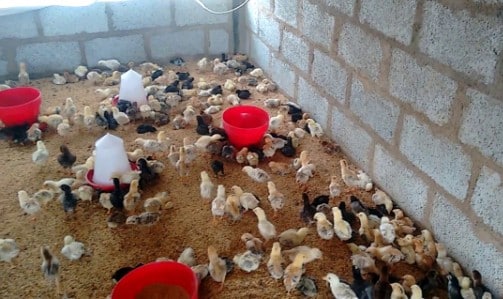
Over a period of time, a hen starts producing less number of eggs and the rate of hatching decreases producing weak chicks. This is because of inbreeding. To avoid inbreeding a farmer has to maintain new cock for every 10 hens every 18 to 24 months. This will maintain healthy poultry stock. Depending on the size and management, a brooding hen can hatch 12 to 16 eggs per sitting. Eggs are to be stored in clean and dry trays in cool places with its broad end facing upwards. Eggs older than 10 days must be avoided for hatching as the chances of hatching will be low. Eggs start to hatch from 21 days, this period is called a brooding cycle. After hatching, a broody hen remains with chicks by not taking them out for food and water for about a day or two. During this time care must be taken by providing clean water and food near the brooding hen.
Country Chicken Farming Project Report – Flock Management
A proper country chicken flock management can be rewarding. A flock can be maintained on farms, backyard or small acreages and with proper care and consideration will lead to good profits. By six weeks, birds will gain 0.65 to 0.75 kg body weight. These birds can be let out in free-range or backyard @ 10 to 20 birds per house depending on the availability of natural feed. Country chicken birds are prone to many predatory birds and animals while becoming an easy prey leading to huge losses. Birds that are closer to roadsides are a hazard both to the motorists and themselves. By early daybreak, the birds are let out for foraging and by night they needed to be provided with night shelter. Sewage and stagnant, dirty water become prone in spreading of disease organisms to the chicken flock. Protect the flock from going to nearby farms which are sprayed with insecticides and pesticides as it will lead to bird deaths. Farm poultry flocks require proper environmental protection such as rain, cold and heat. Birds that go outside must have adequate nutrition. Birds need to be habituated to return to the poultry houses by evenings for night shelter. Poultry houses must be dry with fresh air circulation, avoid moisture conditions inside poultry farms. Poultry houses must be dry, clean and with comfortable bird quarters throughout the year. Chicken flocks apart from the shelter and proper feeding require daily care with constant attention to the birds.
Country Chicken Farming Project Report – Backyard Country Chicken Disease and their Control
Even though country chicken is disease resistant compared with broiler chickens, yet they are prone to diseases. Commercial breeders cull birds that are disease infected to protect spreading of disease which is a harsh reality of chicken farming. Most breeders provide the healthiest diet possible and take measures in maintaining good health of the country chicken flock. But, even while ensuring the health and well-being of the birds; free-range country chicken flocks succumb to diseases.
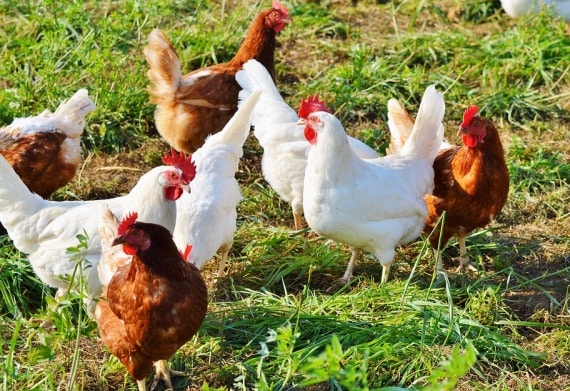
There are more than thirteen diseases and the most five common country chicken diseases are listed below:
Infectious Bronchitis: This is a viral disease and may infect country chicken. Bronchitis spread quickly among the flock through the air and its severity ranges from mild to severe. Those birds that are infected exhibit the following symptoms:
- The decrease in appetite and drinking
- Discharge from the nostrils and eyes
- Birds find difficulty in breathing with raspy breath sounds, coughing and gasping.
- Eggs are often soft-shelled with water inside and misshaped eggs.
Even vaccinated birds may also be prone to this disease and studies shows the recovery rate may increase. Infected birds can be treated with antibiotics and while recovering birds must be provided heat lamp to keep them warm. The best solution to prevent flock from the disease is to keep the bird’s immune system healthy.
Avian Influenza: This disease is commonly known as the Bird-flu. This is a contagious disease and if one bird is affected the entire flock can be affected and even spreads from farm to farm. This disease doesn’t only spread from country chicken, but from any other domestic bird or any wild birds. The disease mainly spreads from the mucus or feces while even insects and rodents can transmit from the infected bird. Infected birds need to be put down and the carcass destroyed completely. Sanitize the places the birds were in before introducing a new flock. There is no vaccine for this disease; we can put to rest the fear of this dreaded disease when you are aware of the symptoms or early signs with timely actions.Those birds which are infected exhibit the following symptoms:
- Respiratory troubles such as coughing, sneezing and breathing problems.
- Chickens stop laying eggs.
- Develop diarrhea.
- Chicken’s face gets swollen.
- Chicken wattle, legs and comb are discolored or have turned blue.
- Bird’s sudden death with no prior sickness signs.
Infectious Bronchitis: This is also commonly called Mycoplasmosis. This disease can be detected when the chickens start sneezing, snoring and coughing. This is a viral disease and transmits quickly through the air. This disease can be controlled by administering the vaccination. Infected chickens are isolated and kept in a warm, dry place to recoup. Those birds that are infected exhibit the following symptoms:
- Sneezing, Coughing and Snoring.
- A foamy discharge can be seen from the nose and sometimes from the eye also.
- Chicken eyes get swollen and sometimes with watery discharge from the eyes.
Fowl Pox: This is another common disease among backyard country chicken flock. This is a viral disease and can be transmitted to others through the air; though this disease has fewer fatalities while going unnoticed in the flock by new chicken keepers. Fowl pox can be controlled through vaccination. Just like chicken pox in humans, white blister-like lesions and scabs are developed on the combs and wattles while in extremely rare cases, lesions appear on the body, legs, mouth, and throat is affected with pox causing breathing problems which leads to bird’s death. Infected birds while undergoing treatment must be isolated in a warm, dry place and fed with soft food during recoup. Scabs that are developed while healing will fall off in about three weeks. Those birds that are infected exhibit the following symptoms:
- White spots like scabs develop on combs and wattles.
- Bird stops laying eggs.
- In extreme cases, breathing problems due to white ulcers developed in mouths or trachea.
Infectious Coryza: This is one of the chicken diseases caused by a bacterium which don’t have vaccination; infected birds can be treated with antibiotics but not with a guaranteed cure. Infected birds will have their eyes, comb, and head swollen. You will observe a white discharge from their eyes and noses along with moisture under their wings. This disease is a life-threatening one, chickens that contract this disease have to be put down and the carcass has to be destroyed completely as it may infect other animals. Those birds that are infected exhibit the following symptoms:
- Birds have a swollen head.
- A white discharge flows from the nose and eyes.
- Infected birds start sneezing with labored breathing.
- Comb and wattles get swollen.
Country Chicken Farming Project Report – Vaccination Program
| Age | Name of the Vaccine | Strain | Dosage (ml) | Route | ||||
| 1st day | Marek’s | HVT | 0.20 | SC Injection | ||||
| 5th day | Newcastle | Lasota | A drop | Eye drop | ||||
| 14th day | Infectious Bursal | Georgia | A drop | Oral | ||||
| 21st day | Pox | Fowl pox | 0.20 | IM / SC injection | ||||
| 28th day | Newcastle | Lasota | A drop | Eye drop | ||||
| 9th week | Newcastle | R2B | 0.50 | SC injection | ||||
| 12th week | Pox | Fowl pox | 0.20 | Sc injection |
The last two vaccines should be administered on every sixth month.
Country Chicken Farming Project Report – Nutrition and Feeding
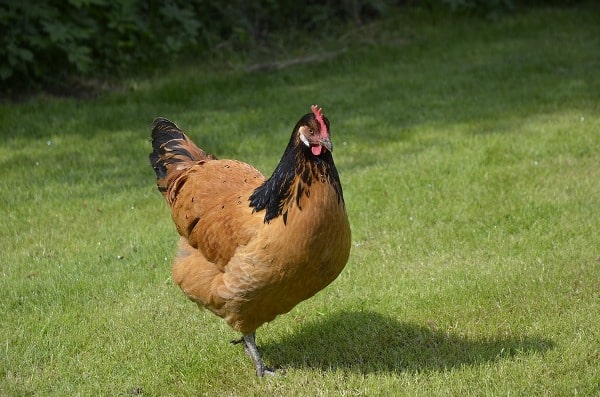
Feed with quality nutrition is the foundation of country chicken health and performance. Country chickens that are raised in the free-range feed on grains, worms, and green plants; they are also prone to feed on junk food that is available in urban areas. Those chickens that fed on junk or fast food will have health problems with shorter life. Feeding chickens in the backyard or in the free range are difficult to tell what exactly to feed when to feed and how much to feed them. Chickens that are raised in free-range farms consume food diet that is available in nature, but to keep them healthy, a grower must also give them a timely nutritious feed. Giving supplemental feed will be based on the purpose of rearing. For egg production country chicken should largely depend on scavenging insects, greens, and other for protein requirement. For meat purpose, country chickens are encouraged to feed on with commercial layer chick feed. Additional supplementation of cereal feed such as Bajra, Ragi (Finger millet), Jowar, broken rice, etc. will be beneficial to sustain country chicken production. Birds suffer from poor feathering, slower growth and more prone to diseases when fed on poor nutritionally balanced diet available on the free-range farm. The most common cause of poor growth in country chicken is a failure to provide a commercial feed that contains fortified supplements with balanced nutrition. Country chicken laying hens must have sufficient calcium @ 3 to 4 grams per bird per day in their diet; roosters require more protein in their diet.
There is a saying from old-timers – ‘feed a chicken as much as it can consume in ten minutes twice a day’. Country chickens that have access to good pasture can be fed twice in a day with mixed grains as they can feed on other organic things in free-ranging but no need feeding at night. Certain foods are to be avoided that include: moldy food, junk food, salty foods, scratch grains and sugary snacks.
Country Chicken Farming Project Report – Boosting Country Chicken Immune System
The immune system is a mechanism that fights off illnesses, diseases, and infections in living things. Flocks with better immune system will have healthy birds in great shape. Proper vitamins, nutrients, minerals, low stresses, good environment and proper rest are some of the things that boost immunity apart from genetic factors, age, and gut health. Some of the natural organic immune boosters are:
Garlic: It is an antimicrobial that powerfully aides in the immune system by repelling parasites. It also helps in deterring intestinal worms. Crush one garlic clove and mix it with one-liter fresh water in multiple feeders as drinking water. Place one more water feeder with ordinary water in it. Do not use garlic water in a metal feeder as garlic will corrode it. Allow the flock to consume garlic, water once in seven to ten days or twice in cold seasons. Excess consumption of garlic, water can lead to Heinz anemia that causes weakness.
Herbs: Herbs aid in chickens health and digestion and many kinds of herbs are recommended as a diet in country chicken growing.
- Oregano: This herb boosts the immune system of the bird and guards the bird against many infections that include infection bronchitis, salmonella, avian influenza and other diseases.
- Cinnamon: This herb has antibacterial properties and works as a great all-rounder in bird’s health. It acts as an antioxidant and reduces inflammation.
- Parsley: This herb is rich in various vitamins such as A, B, C, E and K. Parsley helps in stimulating egg laying.
- Ginger: Ginger is another anti-viral and anti-infective herb that aids the immune system.
- Turmeric: This herb has great antibiotic and anti-infective properties.
Fruits: Fruits are a healthy source of many minerals, vitamins. Chicken feed on many fruits such as bananas, watermelon, grapes, berries and more. Bananas are rich in magnesium, potassium, fiber and rich in Vitamin B. Blueberries are packed with full of vitamins and nutrients such as selenium and phosphorous and help in digestion while act as antioxidants. Strawberries are powerful immune boosters.
Greens: Fresh green veggies are another great part of the country chicken diet. Kitchen waste becomes a rich source of their daily diet in backyard farming. The grass is one of the excellent sources of food, chicken love to feed in the free-range chicken farming. Greens are packed with loads of vitamins and minerals.
Seeds and Grains: Birds love to feed on seeds and grains. Sprouted grains and seeds become excellent nutritious sources.
Country Chicken Farming Project Report – Financial Assistance in Country Chicken Farming
Financial assistance from banks can be availed through loans for existing and new entrepreneurs to construct poultry shed, feed room, and other poultry equipment. Farmers having experience or training on poultry farming and those having land for constructing poultry sheds will be having the added advantage to avail loans early. Banks offer friendly repayment methods to farmers by granting 6 month grace period for doing busing with bi-monthly installments. Collateral security by mortgaging of land will ensure the quick process of financial assistance. However, some state governments will subsidize the interest rate on the loans sanctioned by the commercial banks for the establishment of poultry farms. Hatcheries established with 100% government investment will help in rearing chicks. DWCRA groups can avail full support and training in performing poultry vaccination from the government. And many more subsidies on loans and the rate of interest can be availed by checking particular state government policies on poultry farming.
Country Chicken Farming Project Report- Cost and Profit in Country Chicken Farming
Economics in Country Chicken Farming: Investment and Maintenance pattern for small country chicken farmers in deep litter system. Pricing is subjective to change depending on the local availability of materials. The figures in this project report are not accurate, but assumption to give an understanding to young entrepreneurs on investment and returns on the country chicken business project.
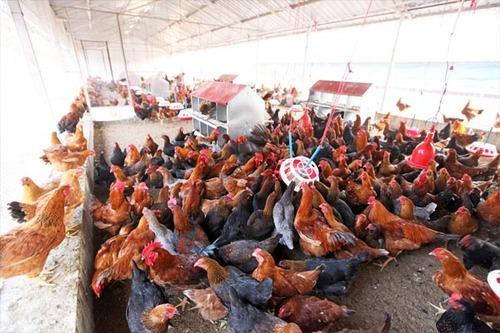
S.No Particulars Cost (Rs)
————————————————————————–
A. Economic Norms
1. Batch size 1500 chicks
2. Mortality rate @ 5% 75
3. No. of batches per year 3
4. Cost of live bird 180/-
5. Average weight of bird 1.5
at the time of sale
6. Eggs per annum per bird 124
- Fixed Investment
- Cost of Shed (3sheds x (60 x 30 ft)) 75,000/-
(Minimal local materials used)
2. Cost of Poultry equipment 18,000/-
Total 93,000/- - Variable Cost
1. Cost of 1500 chicks @ 23/- 34,500/-
2. Cost of feed (3.4x1500x25) 1,27,500/-
3. Vaccination 3,200/-
4. Electricity 3,500/-
5. Labor cost 18,000/-
6. Miscellaneous Charges 6,750/-
Total 1,93,450/-
D. Total Expenditure (B + C) 2,86,450/-
- Income
1. Sale of birds1.5 kg @ 180/- 3,84,750/-
2. Sale of Eggs 15,000/-
3. Sale of manure 850/-
4. Sale of gunny bags 750/-
Total 4,01,350/- - Profit (E – D) Rs. 1,14,900/-
From the next batch sale, the farmer need not invest in fixed expenditure. Hence the profit margin value will increase approximately double. Excluding labor charges and other investment cost. The young farmer can make profits more than two lakhs from the second batch onwards. Selling 3 batches of country chicken per annum, the farmer will make a profit of about six lakhs on a small scale country chicken farming business.
Country Chicken Farming Project Report – Marketing in Country Chicken Farming
Country chicken is in great demand in the local market. Indigenous chicken variety need not need much investment in marketing. To have more profit, it is good to avoid middlemen in the local market. Make a tie-up with local chicken retailers, dhabas, malls, or hotels, as they require country chicken birds on a regular basis.
Country Chicken Farming Project Report – Conclusion
Country chicken farming business is a profit making business and provides job opportunity directly and indirectly to many people. Indigenous breed farming is a simple business for its low maintenance and quality byproducts. Country chicken eggs are rich in nutrients, vitamins, and protein and the meat is one of the protein-rich poultry products.Young entrepreneurs and existing poultry farmers will be able to get a high return on investment.
very good information.
Best information
I want to country chicken farming project.
Read this:Country Chicken Farming.
Thank you very much. Very good information.
I do understood this is for forming country chicken in shed.
Please clarify …
1. Growing from day old chicks buying @ 23/chick?
2. Each shed to accommodate 500 birds?
3. Avg chicken weight 1.5 kg in 4 months? Because 3 Batches one after one means 4 months each per year.
4. Is country chicken forming can avail any subsidy from NABARD?
Country chicken in natural atmosphere will take 8-10 months to reach 1 kg weight…
If it reaches 1.5 kgs in 4 months, It will not be a country chicken …It is so called Country chicken
One day old Pure Country chick cost minimum 40-50 Rs each.
We can get broiler / other Varities for 20-30 Rs
Since We have more than 15 years experience in Country chicken ,
Below points will play a important role in the profit or loss of country chicken farming:
1. Our ( Owner / investor ) personal involvement in chicken farming is important otherwise we will loose money by depending labours for all activities.
2. 70-80% of the feed should be cultivated inside the farm by the farm owner, 20% we can depend on outside feed in rainy seasons.
3. Chicken should be sold every week after 6 months period ( Example : selling 30-50 chicks a month)
4. It is not advisable to sell it to wholesale buyers in single time, They will play in pricing
5. Starting with minimum qty is safer to learn and to avoid huge losses ( Minimum 500-700 chicks)
HI,
I have 2 acres of land and have planes to do desi chicken and kadaknath farming
pleas advice how to start bussiness
Zeeshan Riyaz
What is the weigt/feed covertion ratio to get 1kg wt of chick?
Greetings of the day,
We need to make a project report on country chicks, goat farmiing and dairy farming
kindly let us know the procedure and guide us.
Useful information for new comers
Very nice information jagadish reddy God bless you
Thanks Mr.Reddy.
Can you just help Mee in providing better breeds for eggs in layer.Which can give 200-220 eggs in a year.
Hi
I’m planning on opening a chicken / goat farm
So if you can help with some helpful information it would be good
Need latest report considering current market cost / sales prices.
Especially in Karnataka, costal area.
hi,
I have 8 acres of land and have plans to do country chicken and Kadaknath chicken farming in Jabalpur (Madhra pradesh). I know you may not deal in Kadaknath, please advice how can I start with the business. In case you can provide your expert advice including construction of shed, purchasing of chicks and other information like medicines etc, what are your charges ?
Thanks,
Amarjeet
Really a very useful information those who are in line Agri acrivitis and also to job seekers to start their own venture
at a lower investment.
i have 1 acer land i am intrest disi chicken farm please advice me thanks
I have 15 acres land in Pune region. Iam looking for like minded people as partners in this venture. We wish to do agriculture along with fish farming and other live stock. This will be a all in one project.
where in pune?
My Brother having Half acre Land, Can i Plan for Poultry Farm (Country Desi Chicken Farm). Pls give the more Precautions or suggestions , I have project plan in 2025.
I am interested in country chicken farming sir
nicely and clearly understandable project report with econamics of poultry farming of natu chicken